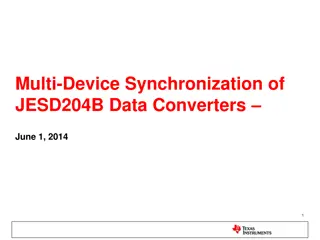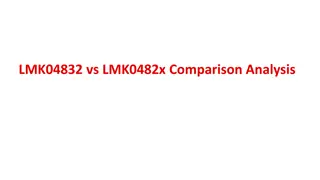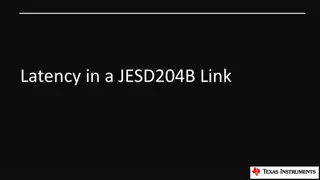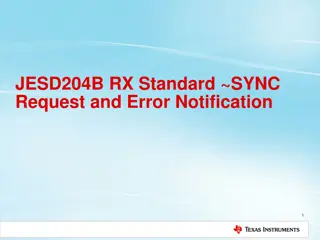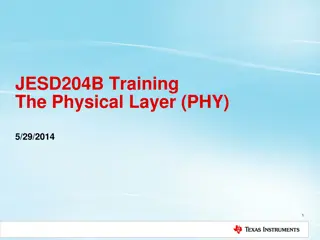Understanding Multi-Device Synchronization in JESD204B Data Converters
Exploring the complexities of achieving multi-device synchronization with JESD204B high-speed data converters. This presentation discusses advantages, disadvantages, and key considerations such as deterministic latency and clock design. Learn about requirements, tools, and synchronization strategies
0 views • 45 slides
Comparison Analysis of LMK04832 vs LMK0482x
General specifications comparison between LMK04832, LMK04828, LMK04821, and LMK04826 including parameters like VCO frequency range, maximum output frequency, input frequencies, PLL specifications, supply voltage, operating temperature, and output formats. Clock output formats, dividers, and delays d
0 views • 5 slides
Understanding and Debugging JESD204B: Practical Guide
This guide provides a comprehensive overview of understanding and debugging JESD204B interfaces. From achieving CGS and ILAS phases to troubleshooting user data alignment issues, it covers essential steps and tips for successful implementation and debugging. The content includes an introduction to t
0 views • 32 slides
Understanding Latency in JESD204B Links
Latency in a JESD204B link refers to the time it takes for a signal to travel from input to output, influenced by factors like system setup, device dependencies, clock propagation delays, and signal alignment. Definitions such as Sample-to-Serial Out (S2SO), Link Delay, and Link Latency are crucial
0 views • 46 slides
Understanding JESD204B RX Standard Synchronization and Error Handling
Explore the key functionalities of the JESD204B RX Standard, including synchronization requests, error detection, and reporting mechanisms. Learn about synchronization upon initialization, error handling requiring re-initialization, and more for reliable data link setup in JESD204B interfaces.
0 views • 11 slides
Understanding JESD204B Physical Layer (PHY) in High-Speed Serial Interfaces
The JESD204B training presentation delves into the Physical Layer (PHY) of high-speed serial interfaces, covering topics such as speed grades, compliance types, SERDES solutions for long channels, clocking information, differential link data transmission, and electrical requirements for drivers and
0 views • 20 slides
